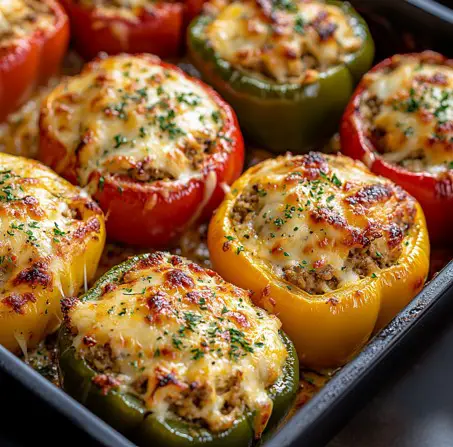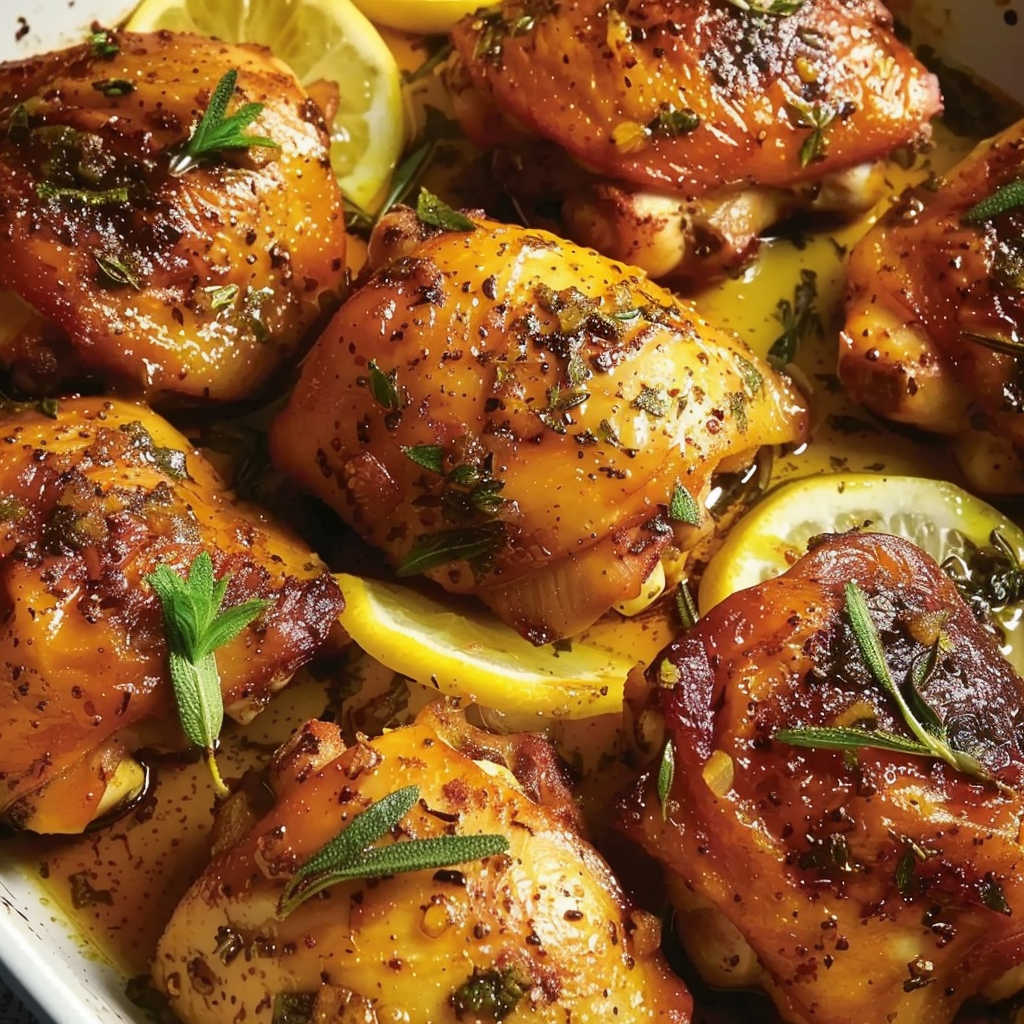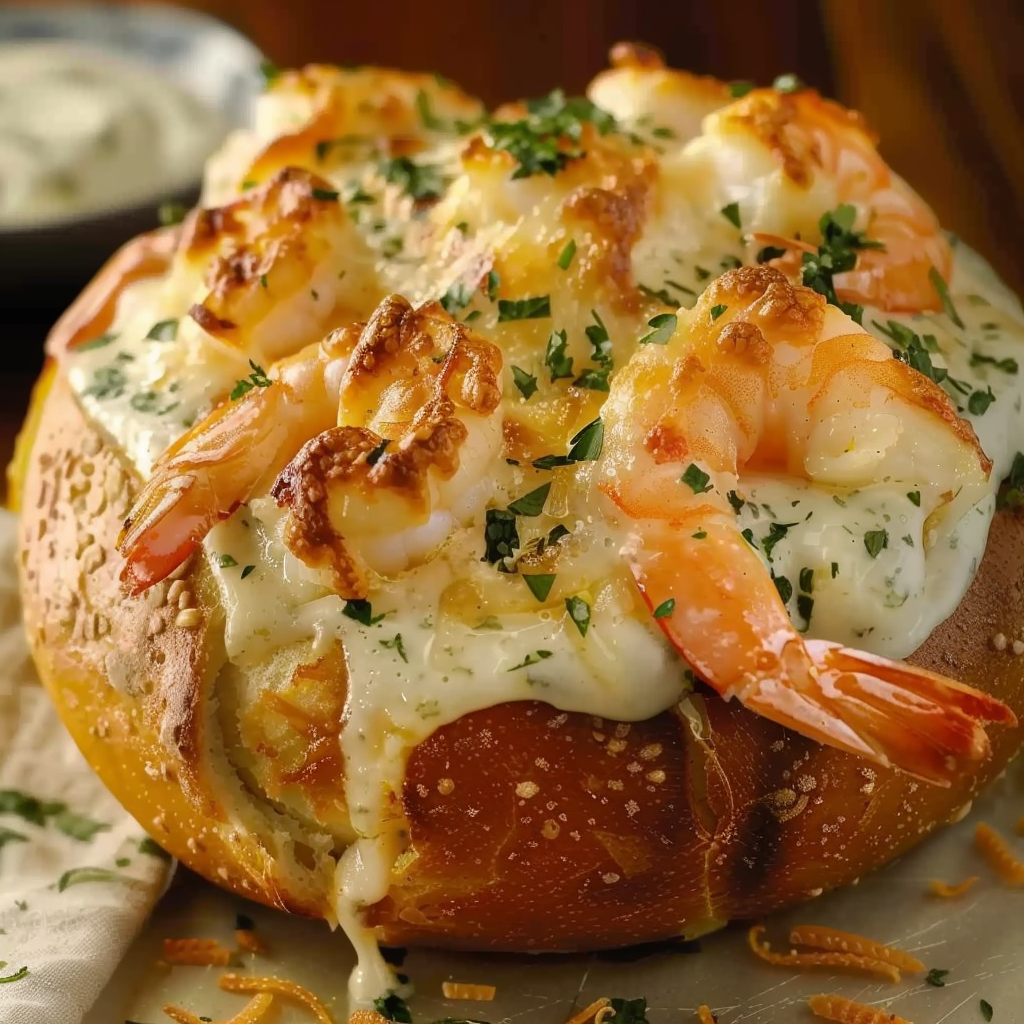Stuffed bell peppers are a classic dish enjoyed in various cuisines around the world. These vibrant vegetables are hollowed out and filled with a delicious mixture of ingredients, then baked to perfection. This versatile recipe is beloved for its combination of textures and flavors, offering a nutritious and satisfying meal.
Brief History and Origin
The practice of stuffing vegetables dates back centuries, with roots in many culinary traditions. The concept of stuffed bell peppers is believed to have originated in the Mediterranean region, where vegetables are frequently used as vessels for flavorful fillings. Variations of stuffed peppers can be found in Greek, Turkish, Spanish, and Italian cuisines, each with its unique blend of ingredients and spices. In the United States, stuffed bell peppers became popular in the mid-20th century as a wholesome, family-friendly dish.
Overview of Nutritional Benefits
Stuffed bell peppers are not only delicious but also packed with nutritional benefits. Bell peppers are low in calories and high in essential vitamins and minerals, particularly vitamin C, vitamin A, and potassium. They are also rich in antioxidants, which help protect the body from oxidative stress. The filling, often made with a combination of protein, grains, and vegetables, adds to the nutritional value by providing fiber, protein, and a range of other vitamins and minerals. This makes stuffed bell peppers a balanced and nutritious option for a main course.
Ingredients and Preparations
Creating delicious stuffed bell peppers starts with selecting the right ingredients and preparing them correctly. This section will guide you through the main ingredients needed, tips on selecting the best bell peppers, and the preparation steps to ensure a successful dish.
List of Main Ingredients
- Bell Peppers: Choose large, firm bell peppers that can stand upright. Common colors include green, red, yellow, and orange, each with a slightly different flavor profile.
- Meat: Ground meat such as beef, turkey, chicken, or pork is commonly used. For a vegetarian version, consider using beans, lentils, or tofu.
- Rice: Cooked rice adds texture and bulk. Brown rice, white rice, or even quinoa can be used as a substitute.
- Vegetables: Onions, tomatoes, corn, and black beans are popular choices to mix with the meat and rice.
- Spices: Common spices include garlic, salt, pepper, cumin, paprika, and Italian seasoning. Fresh herbs like cilantro or parsley can enhance the flavor.
- Cheese: Shredded cheese such as cheddar, mozzarella, or a Mexican blend is often used to top the stuffed peppers.
Tips on Selecting Fresh Bell Peppers
- Firmness: Choose bell peppers that are firm to the touch with smooth, unblemished skin.
- Color: Select peppers with vibrant colors. The brighter the color, the sweeter the pepper tends to be.
- Size and Shape: Opt for large, evenly shaped peppers. They should be big enough to hold the stuffing and stand upright without tipping over.
- Weight: Heavier peppers indicate juiciness and freshness.
Preparations for Stuffing
- Cooking Rice:
- Rinse the rice under cold water.
- Cook according to package instructions, typically in a 2:1 ratio of water to rice.
- For added flavor, cook rice in broth instead of water.
- Prepping Vegetables:
- Onions: Dice onions finely to mix well with the stuffing.
- Garlic: Mince garlic or use a garlic press for even distribution.
- Tomatoes: Use petite diced tomatoes to ensure they blend well with other ingredients.
- Corn and Beans: Rinse and drain canned corn and beans thoroughly.
- Preparing Bell Peppers:
- Wash the bell peppers under cold water.
- Slice off the tops and remove the seeds and membranes inside. If the peppers do not stand upright, slightly trim the bottom without cutting through.
- For a softer texture, consider par-baking the peppers in the oven at 350°F for 10 minutes before stuffing.
Step-by-Step Cooking Instructions
Creating stuffed bell peppers involves several stages: preheating the oven, preparing the peppers, cooking the filling, stuffing the peppers, and finally, baking them. Follow these detailed steps to ensure a successful and delicious outcome.
Preheating the Oven
- Preheat your oven to 375°F (190°C). This ensures the oven is ready to bake the stuffed peppers evenly once they are prepared.
Preparing the Bell Peppers
- Wash the Peppers: Rinse the bell peppers thoroughly under cold water to remove any dirt or residues.
- Cut and Deseed: Using a sharp knife, slice off the tops of the peppers. Carefully remove the seeds and membranes from inside without puncturing the peppers. If needed, trim the bottoms slightly to ensure they stand upright in the baking dish.
Cooking the Filling
- Sautéing Onions and Garlic:
- Heat 2 tablespoons of olive oil in a large skillet over medium heat.
- Add 1 diced onion and sauté until translucent, about 5 minutes.
- Add 3-4 minced garlic cloves and sauté for an additional minute.
- Browning the Meat:
- Add 1 pound of ground meat (beef, turkey, or chicken) to the skillet.
- Cook until browned, breaking it up with a spatula as it cooks, approximately 7-10 minutes.
- Season with salt, pepper, and your choice of spices (e.g., cumin, paprika, Italian seasoning).
- Mixing in Rice and Vegetables:
- Once the meat is cooked, add 1 cup of cooked rice, 1 can of petite diced tomatoes (drained), 1 cup of corn, and 1 cup of black beans (rinsed and drained) to the skillet.
- Stir in 1 cup of shredded cheese (cheddar or mozzarella) and mix well until all ingredients are combined.
- Cook for an additional 2-3 minutes to blend the flavors.
Stuffing the Peppers
- Stuff the Peppers:
- Place the prepared bell peppers in a baking dish.
- Spoon the filling mixture into each pepper, pressing down gently to fill them completely.
- Top each pepper with a sprinkle of additional shredded cheese.
Baking Instructions
- Bake the Peppers:
- Cover the baking dish with aluminum foil and place it in the preheated oven.
- Bake for 30 minutes covered, then remove the foil and bake for an additional 10-15 minutes, or until the peppers are tender and the cheese is melted and bubbly.
Tips for Perfect Results
- Avoiding Sogginess:
- To prevent the peppers from becoming soggy, avoid overcooking them. Par-baking the peppers for 10 minutes before stuffing can help maintain their texture.
- Ensure the filling mixture is not too watery. Drain canned tomatoes and rinse beans and corn thoroughly.
- Maintaining Texture:
- Use a mix of different textures in the filling, such as combining crunchy vegetables with soft rice and ground meat.
- Do not overfill the peppers, as this can cause them to break or spill over.
Variations and Dietary Considerations
Stuffed bell peppers are incredibly versatile and can be adapted to suit various dietary preferences and needs. Here are some popular variations and dietary considerations to help you customize this dish:
Vegetarian and Vegan Options
- Using Beans and Legumes:
- Substitute the meat with protein-rich beans such as black beans, chickpeas, or lentils. These provide a hearty texture and are packed with fiber and nutrients.
- Combine cooked beans with vegetables, rice, and spices for a flavorful filling.
- Quinoa Stuffed Peppers:
- Use quinoa as the base instead of rice for a high-protein, gluten-free option. Quinoa adds a slightly nutty flavor and a pleasant texture.
- Mix quinoa with vegetables like spinach, tomatoes, and mushrooms.
- Tofu or Tempeh:
- Crumbled tofu or tempeh can replace ground meat. Sauté them with spices and vegetables to absorb the flavors.
- Use firm tofu and press it to remove excess moisture before cooking.
Low-Carb and Keto Variations
- Cauliflower Rice:
- Replace traditional rice with cauliflower rice for a low-carb option. Cauliflower rice mimics the texture of regular rice while being significantly lower in carbohydrates.
- Sauté cauliflower rice with garlic, onions, and other vegetables before mixing with the filling.
- Cheese Alternatives:
- Use high-fat, low-carb cheese like cheddar, mozzarella, or cream cheese to add richness to the filling without increasing the carb content.
- For dairy-free keto options, use coconut milk or nut-based cheese alternatives.
Gluten-Free Adaptations
- Rice and Quinoa:
- Ensure the use of gluten-free grains like rice or quinoa for the filling.
- Avoid any pre-made spice mixes or sauces that may contain gluten. Use fresh herbs and spices instead.
- Bread Crumb Alternatives:
- If a recipe calls for breadcrumbs, use gluten-free breadcrumbs or crushed gluten-free crackers to maintain the texture without gluten.
Adding Variety with Different Meats and Seasonings
- Different Meats:
- Experiment with different types of ground meats such as turkey, chicken, pork, or even seafood like shrimp or crab for unique flavors.
- Each type of meat brings its distinct taste and texture to the dish.
- Seasonings and Herbs:
- Change the flavor profile by using different spices and herbs. For example, use cumin, coriander, and chili powder for a Mexican twist, or oregano, basil, and thyme for an Italian version.
- Fresh herbs like cilantro, parsley, or dill can enhance the flavor and presentation.
Serving Suggestions and Pairings
Stuffed bell peppers make a complete and satisfying meal, but they can be complemented with a variety of side dishes and garnishes to enhance the dining experience. Here are some suggestions to consider:
Suggested Side Dishes
- Salads:
- Mixed Green Salad: A simple mixed green salad with a light vinaigrette complements the rich flavors of stuffed bell peppers without overpowering them.
- Greek Salad: Combining cucumbers, tomatoes, olives, and feta cheese with a lemon-oregano dressing provides a refreshing and tangy side.
- Roasted Vegetables:
- Roasted Asparagus: Lightly seasoned and roasted asparagus spears add a crunchy texture and a mild flavor that pairs well with the stuffed peppers.
- Brussels Sprouts: Roasted Brussels sprouts with a drizzle of balsamic glaze offer a slightly sweet and caramelized contrast to the savory peppers.
- Grains and Starches:
- Quinoa Pilaf: A quinoa pilaf with herbs and nuts can add an additional layer of texture and nutrition.
- Garlic Bread: Warm, crispy garlic bread can be a delightful accompaniment, especially with Italian-style stuffed peppers.
Presentation Tips
- Plating: Serve the stuffed peppers in a shallow bowl or a plate with a slight rim to catch any juices. Arrange them in a way that showcases their vibrant colors.
- Layering: If serving multiple stuffed peppers, stagger them slightly for a visually appealing arrangement.
- Serving Dish: Consider using a decorative baking dish that can go from oven to table, enhancing the presentation and keeping the peppers warm.
Garnishing Ideas
- Fresh Herbs:
- Cilantro: Fresh cilantro leaves can add a pop of green and a hint of citrusy flavor, ideal for Mexican-style stuffed peppers.
- Parsley: Chopped fresh parsley provides a bright, clean taste and adds visual appeal.
- Cheese:
- Crumbled Feta: For a Mediterranean twist, sprinkle crumbled feta cheese over the top of the stuffed peppers before serving.
- Grated Parmesan: A light dusting of grated Parmesan can add a savory, umami flavor.
- Sauces:
- Salsa: A spoonful of fresh salsa can add a spicy and tangy element to each bite.
- Yogurt Sauce: A cool, creamy yogurt sauce with garlic and herbs can provide a refreshing contrast to the warm peppers.
- Balsamic Reduction: Drizzling a balsamic reduction over the peppers can add a sweet and tangy finish.
Common Mistakes and How to Avoid Them
Making stuffed bell peppers can be straightforward, but there are a few common pitfalls that can affect the final dish. Here are some typical mistakes and how to avoid them:
Overcooking or Undercooking the Peppers
- Overcooking:
- Issue: Overcooked peppers can become mushy and lose their shape, making the dish less appealing.
- Solution: Pre-bake the peppers for about 10 minutes at 350°F before stuffing them. This helps soften them slightly without overcooking. After stuffing, bake them at 375°F for 30 minutes covered with foil, then uncover and bake for an additional 10-15 minutes to ensure even cooking.
- Undercooking:
- Issue: Undercooked peppers can be too firm, making them difficult to eat.
- Solution: Ensure the peppers are evenly pre-baked and that the filling is hot when placed inside the peppers. Adjust cooking time based on the size and thickness of the peppers.
Filling Falling Apart
- Issue: A filling that falls apart can lead to a messy presentation and uneven bites.
- Solution: Use a binder in the filling, such as eggs or cheese, to help hold the ingredients together. Mixing the filling thoroughly so that all components are evenly distributed also helps maintain consistency.
Balancing Moisture Content
- Issue: Too much moisture can make the filling watery and cause the peppers to become soggy.
- Solution: Drain any canned vegetables (like tomatoes and beans) thoroughly before adding them to the filling. Cook off excess moisture from the meat and vegetables by sautéing them until most of the liquid has evaporated.
- Issue: Too little moisture can make the filling dry and crumbly.
- Solution: Ensure there is enough sauce or liquid (such as tomato sauce or broth) in the filling to keep it moist but not watery. Adding a small amount of broth or sauce to the filling can help achieve the right consistency.
Health Benefits and Nutritional Information
Stuffed bell peppers are not only a tasty meal but also a highly nutritious one. They offer a variety of health benefits due to their rich nutritional content, which varies depending on the specific ingredients used in the filling. Here is a detailed breakdown of the nutritional benefits:
Detailed Nutritional Breakdown
The nutritional content of stuffed bell peppers can vary based on the ingredients, but here is an approximate nutritional profile per serving (one stuffed pepper):
- Calories: 250-350 kcal
- Protein: 15-25 grams
- Carbohydrates: 20-30 grams
- Fat: 10-20 grams
- Fiber: 5-10 grams
- Vitamins and Minerals:
- Vitamin C: 100-200% of the Daily Value (DV)
- Vitamin A: 50-100% of the DV
- Potassium: 10-15% of the DV
- Folate: 10-15% of the DV
- Iron: 10-20% of the DV
Health Benefits of Bell Peppers
- High in Vitamin C:
- Bell peppers are particularly high in Vitamin C, with a single pepper providing over 150% of the recommended daily intake. Vitamin C is essential for immune function, skin health, and antioxidant protection.
- Rich in Antioxidants:
- Bell peppers contain various antioxidants, including capsanthin, quercetin, and luteolin. These compounds help combat oxidative stress and reduce inflammation, potentially lowering the risk of chronic diseases such as heart disease and cancer.
- Low in Calories:
- Bell peppers are low in calories but high in water and fiber, making them an excellent choice for weight management and maintaining a healthy diet.
Benefits of Various Fillings
- Lean Proteins:
- Ground Turkey or Chicken: These provide high-quality protein with less fat compared to ground beef. Protein is essential for muscle repair and growth, and maintaining a healthy metabolism.
- Beans and Legumes: Black beans, lentils, and chickpeas are great plant-based protein sources, rich in fiber and essential nutrients, making them suitable for vegetarians and vegans.
- Fiber from Vegetables:
- Adding vegetables like onions, tomatoes, and spinach to the filling increases the fiber content, promoting digestive health and helping to regulate blood sugar levels. Fiber is also known to support heart health by lowering cholesterol levels.
- Healthy Fats:
- Cheese and Avocado: These add healthy fats to the meal. Healthy fats are necessary for brain health, hormone production, and the absorption of fat-soluble vitamins.
FAQs
Can I Freeze Stuffed Bell Peppers?
Yes, you can freeze stuffed bell peppers. To do so, prepare the peppers as usual but do not bake them. Instead, place the stuffed peppers on a baking sheet and freeze until solid. Once frozen, transfer them to a freezer-safe container or bag. They can be stored in the freezer for up to 3 months. To cook, thaw them in the refrigerator overnight and bake at 375°F for about 30-40 minutes, or until heated through.
What Are the Best Types of Peppers to Use?
The best types of peppers for stuffing are large bell peppers that can stand upright. Red, yellow, and orange bell peppers are sweeter and milder compared to green bell peppers, which have a slightly bitter taste. Choose peppers that are firm and have smooth, shiny skin.
How Do I Make Stuffed Bell Peppers Ahead of Time?
To make stuffed bell peppers ahead of time, prepare the peppers and filling as directed but do not bake them. Store the stuffed peppers in an airtight container in the refrigerator for up to 24 hours. When ready to bake, let them come to room temperature for about 30 minutes, then bake at 375°F for 30-40 minutes.
Can I Use Leftover Stuffing for Other Recipes?
Yes, leftover stuffing can be repurposed in various ways. It can be used as a filling for tortillas to make burritos or enchiladas, mixed with pasta for a hearty casserole, or served over a bed of greens for a nutritious salad. You can also use it as a topping for baked potatoes or as a filling for omelets.
What Are Some Common Substitutes for Rice in Stuffed Peppers?
Common substitutes for rice in stuffed peppers include:
- Quinoa: A high-protein, gluten-free grain that adds a nutty flavor and texture.
- Cauliflower Rice: A low-carb option that mimics the texture of rice.
- Barley: A chewy grain that adds a hearty texture.
- Couscous: A quick-cooking pasta that can easily replace rice.
Conclusion
Stuffed bell peppers are a versatile and nutritious dish that can be easily adapted to suit a variety of dietary preferences and tastes. From the rich vitamin content of the bell peppers to the protein and fiber provided by various fillings, this recipe offers numerous health benefits. Whether you prefer a traditional meat filling, a vegetarian option with beans and quinoa, or a low-carb version with cauliflower rice, there is a stuffed pepper recipe for everyone.
We encourage you to experiment with different ingredients and seasonings to make the dish your own. Share your personal recipes and experiences with stuffed bell peppers to inspire others to enjoy this delicious and healthy meal.
Print
Stuffed Bell Peppers with Ground Beef and Brown Rice
Description
Stuffed bell peppers are a delicious and nutritious dish that combines the natural sweetness and crunch of bell peppers with a savory filling. This filling typically includes a mix of ground meat, rice, vegetables, and spices, all topped with melted cheese. Perfect for a family dinner or meal prepping, this recipe is versatile and can be easily adapted to suit various dietary needs, including vegetarian, vegan, and low-carb options.
Ingredients
- 2 Tablespoons Extra-virgin Olive Oil
- 1 Medium Onion, diced
- 2–3 Garlic Cloves, minced
- 1 pound Lean Ground Beef
- 1½ Cup Cooked Brown Rice
- 1 14.5 ounces Can Diced Tomatoes
- 1 Tablespoon Tomato Paste
- 1 Teaspoon Dried Oregano
- 1 Tablespoon Smoked Paprika, see notes
- Kosher salt and pepper, to taste
- 7 Large Bell Peppers, top and core removed
- 1 Cup Shredded Cheddar Jack Cheese
- Freshly chopped parsley, for garnish
Instructions
-
Preheat your oven to 375F and place the peppers cut side up into a baking dish or a rimmed tray.
-
Heat oil in a large pan over medium heat. Sauté onion until softens, then stir in garlic and cook for about 1 minute more.
-
Add ground beef and cook until no longer pink, breaking up meat with a wooden spoon, for 5-6 minutes. Stir in cooked brown rice, diced tomatoes, tomato paste, oregano, and smoked paprika.
-
Cook until sauce is slightly reduced, about 4-5 minutes. Taste and season with salt and pepper as needed.
-
Stuff each pepper with beef mixture and bake until peppers are mostly tender. About 10-12 minutes.
-
Sprinkle with cheese and bake for 5-7 minutes more. Garnish with fresh chopped parsley before serving. Enjoy!
Notes
- Make Ahead: You can prepare the peppers and filling ahead of time. Store them in the refrigerator for up to 24 hours before baking.
- Freezing: Freeze the stuffed, unbaked peppers on a baking sheet. Once solid, transfer them to a freezer-safe container. Thaw in the refrigerator overnight before baking.
- Variations: For a vegetarian version, substitute the meat with beans, quinoa, or tofu. For a low-carb option, use cauliflower rice instead of regular rice.









